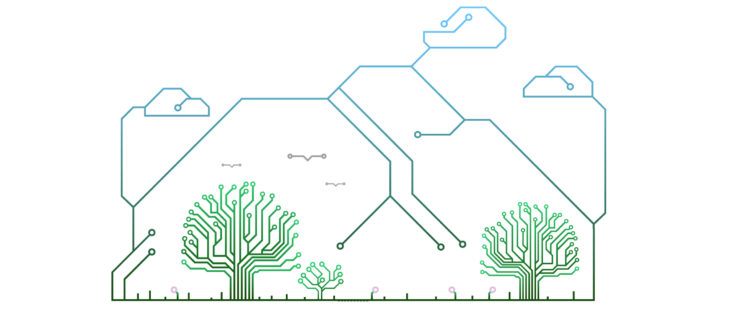While we are examining the paths towards bioeconomy transformation in Finland, digitalization changes the whole global economic environment rapidly and systematically. A clear sign of digital transformation is that new global service platforms are entering the market and challenging the existing market entirely, e.g. Uber or AirBnB. Would similar disruption be possible in the bioeconomy?

At VTT, we believe that it is possible and we are helping Finnish industry and companies to realize these visions.
Important drivers for digitalization are the enabling technologies, such as sensors, smart connected devices, wireless networks, cloud service platforms and data flow solutions, and easy access to computing power.
The outstanding scalability of digital solutions, large volume supply of devices and competition between global platform providers keep the capital expenditure costs low and make technologies accessible to anyone. Devices, sensors and functions can be distributed everywhere, which makes it possible to control the useful data in real-time and to build services utilizing the data.
Understanding the value of data
Data is the key to creating valuable information. The more data that are available, the better; the more accurate the data are, is even better. That is, in order to benefit from the data, the quality of data needs to be taken into account.
Typically, efficient utilization of data enables productivity increases by process optimization, creation of new service offerings or creation of new business models that can disrupt the existing value chains. When the value of data is truly understood, there is also a stronger need to pay attention to data ownership, privacy and security issues.
Potential industrial beneficiaries of digitalization can be, for example, agricultural food production and plant growth monitoring, animal production and animal health monitoring, sorting and logistics efficiency and in controlling distributed and localized processes.
Roadmap to digitalized bioeconomy
As a part of the Bioeconomy programme, in cooperation with Natural Resources Institute Finland (Luke), VTT developed a roadmap towards a digitalized bioeconomy. The goal was to identify the branches of the bioeconomy that can benefit from digitalization, and create ideas on digital applications and solutions, which promote bioeconomy.
There were three key targets identified for digitalization in the bioeconomy.
The first one is to increase the efficiency of existing production processes. This requires digital solutions for the management of big raw material streams, improved logistics, and tailored solutions for specific uses.
Secondly, digitalization enables the development of new bio-based products and services, business models, as well as other operational models for bioeconomy actors.
The third target is to increase transparency and openness in various bioeconomy-related operations and actions.
To achieve these goals, we identified three main action pathways towards a digitalized bioeconomy:
1. Efficient management of raw-material streams.
This path is about gaining more value from raw-material by more efficient and optimal use of different raw material fractions for different uses. Digital applications can be developed for matching the right quality of raw-material to a certain end use, smart logistics and agile operations.
2. Data-based business models and decision-making tools for the bioeconomy.
The availability and use of data was identified as a key element of the digitalization of the bioeconomy. This pathway is about gaining more value from existing data and utilization of novel data generation methods to increase the amount of data to be used for the purposes of decision-making in companies, governance and among consumers. Digital solutions can increase transparency and enable anticipatory decision-making.
3. Network-based business models and collaborative governance of natural resources.
The third pathway deals with the development of digital platforms that enable the networking of bioeconomy actors and new business models for collaborative governance of natural resources. In other words, it is about gaining more value from cooperation networks.
Value from sensors
Advanced sensors can be used as a source of more accurate data or obtaining data from a place not currently accessible. Therefore, advanced sensors can be very important value creating tools and business differentiators for the data-driven business. Supplying sensors as a part of data-driven services can also be a path to easier access or even to ownership of data.
Many times, the advanced sensor is also a significant opportunity to obtain intellectual property protection for the data-driven business and that way reduce investment risks. VTT has a significant patent portfolio (over 350 patent families), out of which as many as 41% belong to sensors, measurement techniques and their integration. VTT licenses, transfers and creates spin-off companies through IPR for the benefit of Finnish industry.
In the bioeconomy branch, VTT’s sensor and monitoring technologies have already created new data-driven business opportunities as illustrated in Figure 2 and described in the following case examples.
Customer in central focus
New digital technologies, including efficient use of data, can create opportunities for new services or other offerings to customers.
In general, digitalization drives the servitization of companies. At the same time also user expectations towards services provided to them are changing, whether the users are employees in a company, citizens, or consumers.
Technological advancements and digitalization have changed the role and power of users and customers, who now have access to vast amounts of information and the ability to experiment, share, and interact with one another.
Advanced sensor systems enable efficient collection of data in different forms, but when utilizing the data for creating a new service offering it is necessary to put the customer in central focus. Understanding customer needs is a key factor for successful service design.
This is also required for strategic decisions within companies. Clear service strategies help companies to redefine their current and future position in the market and the actions necessary to reach their goals, and also how to effectively manage and price the new costs inherent in the service business.
Contact
Mikko Utriainen
phone: +358407537415
email: mikko.utriainen@vtt.fi
Source
Supplier
Airbnb
Natural Resources Institute Finland
Technical Research Centre of Finland (VTT)
UBER
Share
Renewable Carbon News – Daily Newsletter
Subscribe to our daily email newsletter – the world's leading newsletter on renewable materials and chemicals












